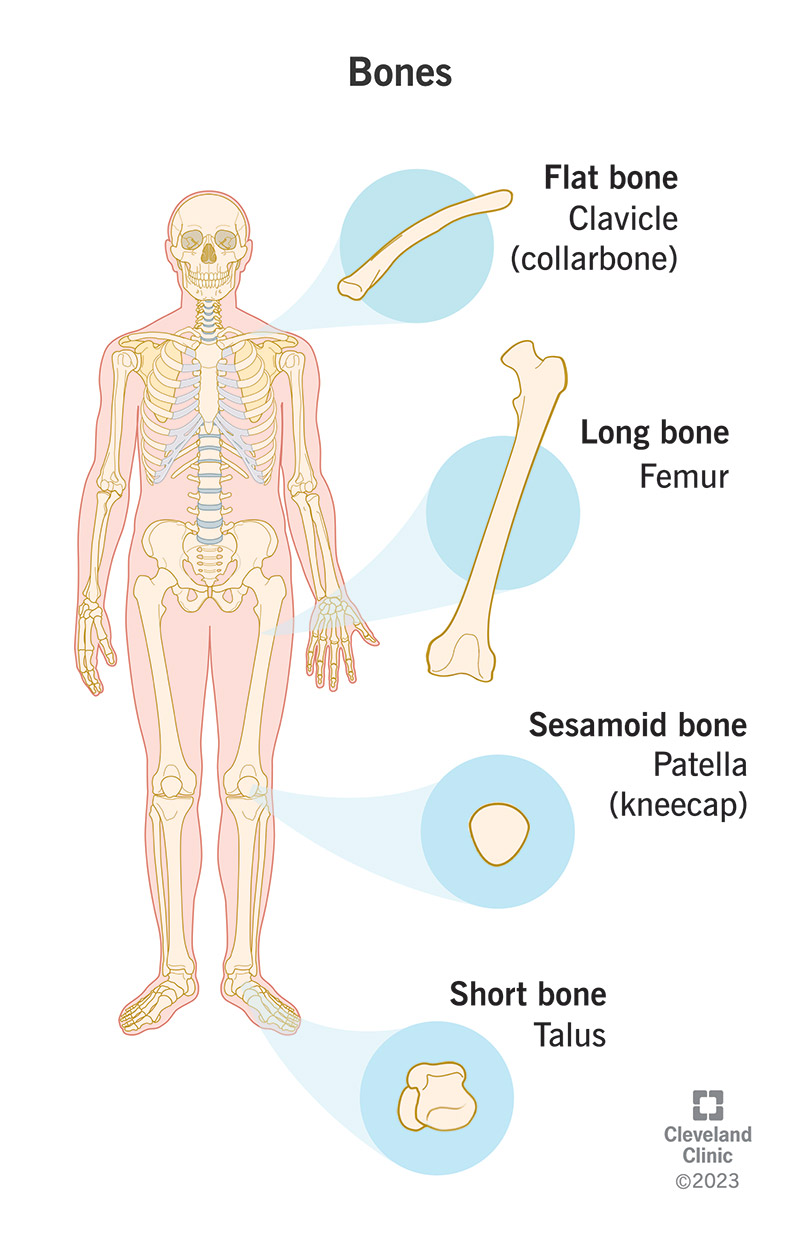Adults have between 206 and 213 bones. You use all of them each day to sit, stand and move. Your bones protect your internal organs and give your body its shape. Bones can maintain themselves. But health conditions like osteoporosis can make you more likely to break bones or have other complications.
Advertisement
Cleveland Clinic is a non-profit academic medical center. Advertising on our site helps support our mission. We do not endorse non-Cleveland Clinic products or services. Policy

Bones are your body’s main form of structural support. They’re made of hard, strong tissue that gives your body its shape and helps you move.
Advertisement
Cleveland Clinic is a non-profit academic medical center. Advertising on our site helps support our mission. We do not endorse non-Cleveland Clinic products or services. Policy
Your bones are like the frame under the walls of your home. If you’ve ever watched a home improvement show and seen the internal structure of a house, that’s what your bones are. They’re the supports and beams that keep your body strong and stable.
Your bones are living tissue like any other part of your body. It might not seem like it. But they’re constantly growing, changing and reshaping themselves.
Visit a healthcare provider if you feel bone pain. Go to the emergency room if you experience trauma or think you might have a broken bone.
Your bones support your body. They keep your body stable when you’re not moving. And they help you move when you’re active.
Bones secure and support lots of important tissue throughout your body. Think about the walls of your home again. Instead of holding drywall, plumbing and wiring in place, your bones are connected to a lot of tissue. Examples include:
Some bones protect your internal organs. For example, your skull guards your brain. And your ribcage shields your heart, lungs and other organs near your chest.
Bones contain and protect your bone marrow. Bone marrow is a soft, fatty tissue that produces important cells, like:
Advertisement
Adults have between 206 and 213 bones. Babies are usually born with 270 bones that grow together and fuse into their adult skeletons.
It might be surprising to learn that some people have more bones than others. The range comes from differences in people’s skeletons. Some people have a different number of ribs. Or you may have fewer bones in your spine than usual.
Healthcare providers divide your bones into two main groups:
Healthcare providers classify bones based on shape and size.
Long bones are exactly what they sound like. They’re the longest bones in your body. They’re mostly in your arms and legs. Examples of long bones include your:
Short bones are thinner and weaker than long bones. They include:
Flat bones are wider and less round than other bones. Some examples are:
Sesamoids are small bones embedded in tendons or muscles. They’re usually near joints. Some examples include:
These are bones that don’t fit well into any other category. They can have a shape or structure that doesn’t match any other type of bone. Some irregular bones include your:
Bones are made of cells and proteins. They have two main layers:
Your bones replace their own cells throughout your life. Special cells called osteoblasts and osteoclasts automatically grow and replace your bone tissue. Osteoblasts form new bone tissue. Osteoclasts break down old bone tissue to make room for new, healthier tissue to replace it.
The periosteum covers most of your bones. It’s a network of blood vessels and nerves that wraps around them. It gives them fresh blood and their ability to feel.
Advertisement
Broken bones and osteoporosis are the most common bone issues.
A fracture is the medical name for a broken bone. Any bone can break. It’s more common in smaller, weaker bones. Breaking stronger bones can happen during a serious trauma like a car accident. Go to the emergency room if you think you have any kind of fracture, no matter which bone is broken.
Osteoporosis weakens your bones. This makes them more likely to break suddenly. Many people don’t know they have osteoporosis until it causes a fracture. There usually aren’t obvious symptoms. Talk to a healthcare provider about a bone density test. Especially if you’re over 65 or know osteoporosis runs in your family.
Your thigh bone is the longest, biggest bone in your body. Its medical name is the femur. Most adults’ femurs are around 18 inches long. That’s around 46 centimeters.
The femur is also the strongest bone. It can support up to 30 times your body weight.
The three ossicle bones in your ear are the smallest bones in the body. These tiny bones are important to your hearing. They carry sound vibrations to your inner ear. The hammer (malleus), anvil (incus) and stapes (stirrup) are all less than an inch (2.54 cm) long. The stapes is the smallest. It’s usually one-tenth of an inch long (3.5 mm).
Advertisement
Whether you’re having a lazy day at home or training for a half-marathon, your bones support your body. They help you move. Or sit still on the couch. All the bones in your body are important. From the tiny bones in your ear to the long bones in your legs.
Anything you do to maintain your overall health will help keep your bones strong and healthy. Talk to a healthcare provider about a bone density test if you’re over 65 or have a family history of osteoporosis.
Advertisement
Cleveland Clinic’s primary care providers offer lifelong medical care. From sinus infections and high blood pressure to preventive screening, we’re here for you.

Last reviewed on 10/17/2025.
Learn more about the Health Library and our editorial process.